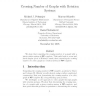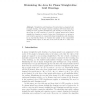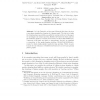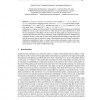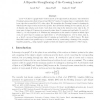GD
2007
Springer
14 years 6 months ago
2007
Springer
Abstract. A graph is planar if and only if it does not contain a Kuratowski subdivision. Hence such a subdivision can be used as a witness for non-planarity. Modern planarity testi...
GD
2007
Springer
14 years 6 months ago
2007
Springer
GD
2007
Springer
14 years 9 months ago
2007
Springer
This paper describes novel methods we developed to lay out graphs using Sugiyama’s scheme [16] in a tool named GLEE. The main contributions are: a heuristic for creating a graph ...
GD
2007
Springer
14 years 9 months ago
2007
Springer
The odd crossing number of G is the smallest number of pairs of edges that cross an odd number of times in any drawing of G. We show that there always is a drawing realizing the o...
GD
2007
Springer
14 years 9 months ago
2007
Springer
We show that computing the crossing number of a graph with a given rotation system is NP-complete. This result leads to a new and much simpler proof of Hlinˇen´y’s result, tha...
GD
2007
Springer
14 years 9 months ago
2007
Springer
Straight-line grid drawings of bounded size is a classical topic in graph drawing. The Graph Drawing Challenge 2006 dealt with minimizing the area of planar straight-line grid draw...
GD
2007
Springer
14 years 9 months ago
2007
Springer
In John Tantalo’s on-line game Planarity the player is given a non-plane straight-line drawing of a planar graph. The aim is to make the drawing plane as quickly as possible by m...
GD
2007
Springer
14 years 9 months ago
2007
Springer
GD
2007
Springer
14 years 9 months ago
2007
Springer
A geometric simultaneous embedding of two graphs G1 = (V1, E1) and G2 = (V2, E2) with a bijective mapping of their vertex sets γ : V1 → V2 is a pair of planar straightline drawi...
GD
2007
Springer
14 years 9 months ago
2007
Springer
Let G = (V, E) be a graph with n vertices and m ≥ 4n edges drawn in the plane. The celebrated Crossing Lemma states that G has at least Ω(m3 /n2 ) pairs of crossing edges; or ...

